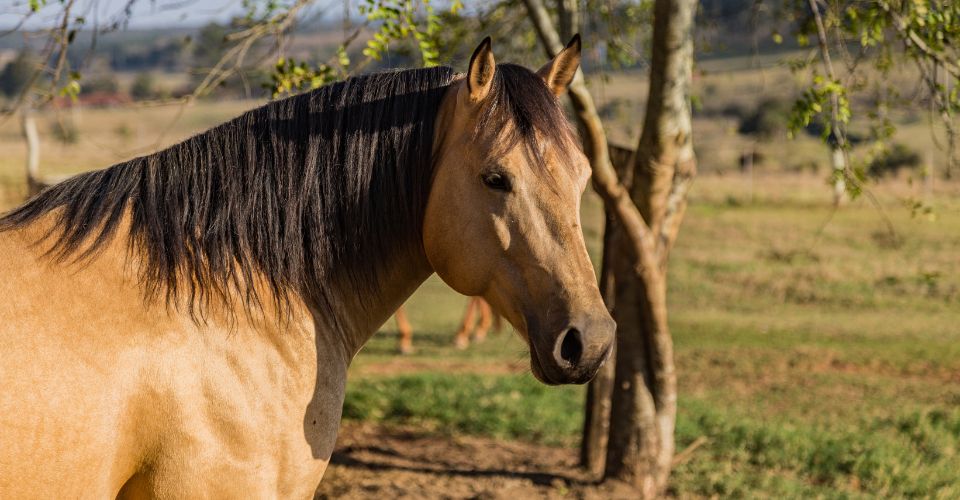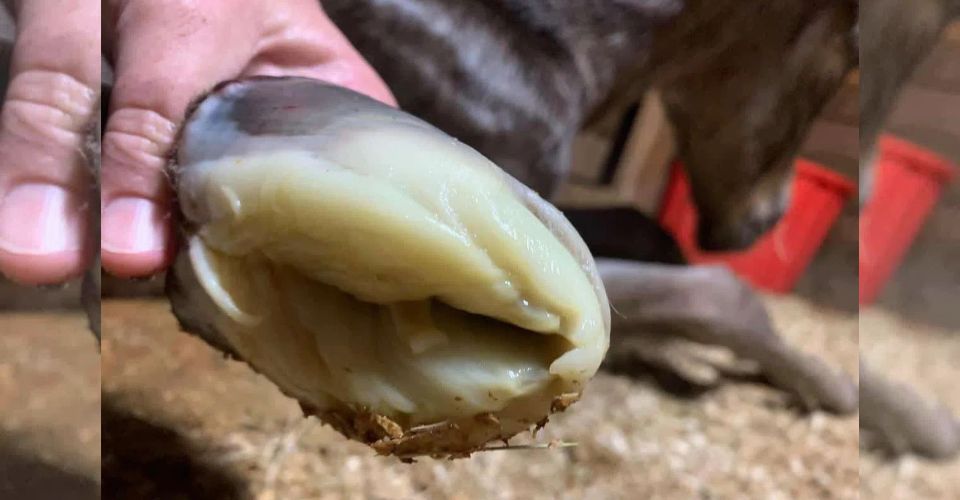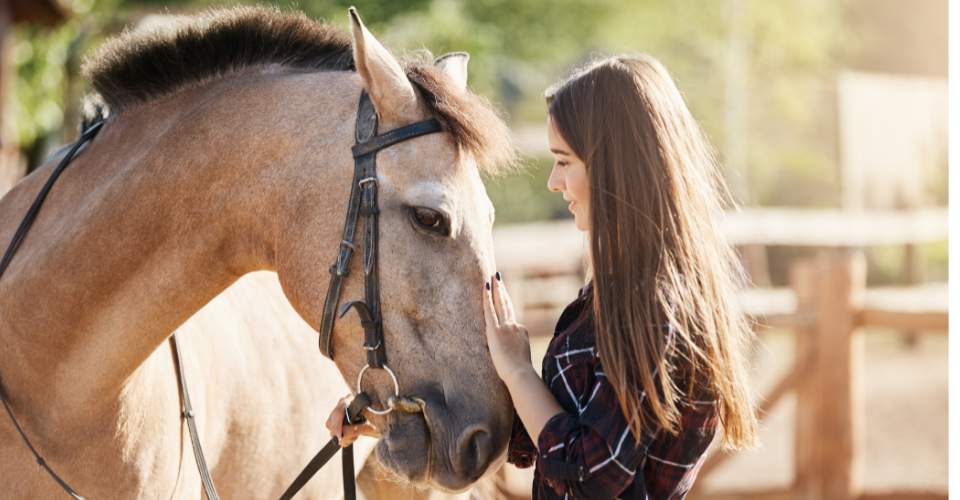Horses with blue eyes are not very common, although they do exist. Some find them fascinating, while others find themselves petrified by their eeriness. They certainly make for a unique sight, and as a result, many myths and legends about them have persisted to this day.
Horses may have two blue eyes or one blue and one brown eye. The lack of pigmentation in the iris basically causes the blue color. Although the genetics behind a horse’s walleye remain unknown, several breeds, including Thoroughbreds, Tennessee walkers, Quarter horses, and Arabians, have some registered horses with blue eyes.
Light-colored Quarter horses and Paints are more likely to have blue eyes. The plausible explanation for this is that blue eyes are generated by a creme gene that causes a double-dilute coat color.
We all have heard about the problems of blue-eyed horses. Some believe they are overly sensitive to the sun, mentally unwell, more prone to skin cancer, and can eventually go blind. Is any of it authentic, though? You might be surprised by the truth.
Wall-Eyed Horses
Blue-colored eyes in horses are known as walleye. Blue eyes are found in horses with the double-dilute creme gene, champagne-colored, and Cremello horses. This dominating gene produces the same pigment dilution as the dilute genes responsible for Cremello bodies in certain horses.
Blue eyes are possible in horses with coats other than Cremello horses. Overos, or horses with white spots, are the most prevalent. Blue eyes, as well as a white blaze or other white on the head, are particularly frequent in overos. However, not all overo horses have blue eyes.
Why Do Some Horses Have Blue Eyes?
Genetics determines the color of a horse’s eyes. If a horse’s coat color is double-dilute due to the creme gene, it will have two light-colored eyes that seem blue.
The iris reflects the color of the eyes. It controls the quantity of light that reaches the retina. The quantity of pigment and melanin in a horse’s eye determines its color. The deeper their eye color, the richer the pigment in their iris. The iris of light-colored eyes, such as blue, green, and grey, has less melanin.
Some horses have varying levels of pigment in their eyes. A horse may have one blue eye and one brown eye if this happens; this is known as full heterochromia. Horses can also have different colored portions of the same eye, a condition known as segmental heterochromia.
The majority of information is speculation, as no one knows why certain horses have blue eyes. However, horses with two blue eyes are more likely to have double-dilution color coat genes.
Horse Breeds with Blue Eyes
Blue eyes in horses are most common in breeds with white or cream coat colors. The Paint Horse, Quarter Horse, Appaloosa, and Tennessee walking horse are the most common horse breeds with blue eyes. Blue eyes are also seen in the Akhal Teke, Gypsy Vanner, and Miniature Horse breeds. There have also been indications of an increase in the number of blue-eyed Thoroughbreds and Arabians.
Medical Conditions that Cause Blue Eyes
A horse’s eye may seem white or hazy due to a variety of health issues. This is not to be confused with a horse’s natural walleye or blue eye.
Inflammation of the cornea and cataracts are two frequent eye diseases that cause the eye to appear hazy and lose brown pigmentation. Corneal inflammation can be caused by increased pressure in the eye or by a corneal ulcer, which is frequently induced by eye trauma. In contrast to corneal inflammation, cataracts create white hazy coloration on the lens within the eye rather than on the surface. Cataracts afflict some horses from birth, while others develop them as a result of sickness or injury.
Caution!
Contact your veterinarian if your horse’s eyes become white or clouded or if they lose pigmentation.
Health Concerns Regarding Horses with Blue Eyes
There are some health concerns regarding blue-eyed horses. However, these health conditions are not only subjective to horses with blue eyes.
Ocular Squamous Cell Carcinoma (SCC)
Ocular squamous cell carcinoma (SCC) is the second most common type of cancer in horses, affecting their eyes and eyelids. Exposure to ultraviolet rays is a potential risk in the development of SCC. It frequently manifests as tumors in the epidermis, conjunctiva, or corneal cells. Horses with no pigment in the skin around their eyes are the most vulnerable to SCC. The pink skin surrounding the eyes of blue-eyed horses makes them vulnerable to UV exposure and ocular squamous cell carcinoma damage.
The occurrence of eye-related conditions in blue-eyed horses was investigated in a 2014 research. The findings were compared to those of a study of brown-eyed horses. Horses with blue eyes have a higher risk of developing ocular squamous cell carcinoma (SCC) than horses with brown eyes, but they are not at higher risk for any other health problem or visual impairment than horses with brown eyes, according to the research.
Sensitivity to Light
The eyesight of blue-eyed horses is identical to that of brown-eyed horses. If the skin around their eyes is pink, ultraviolet sun rays might pose a risk. However, not every horse with blue eyes has pink skin around its eyes. So, the blue color of their iris is not more light-sensitive, but the skin around their eyes is.
Read: Can Horses Swim?
Busting Blue-Eyed Horse Myths
There are ample blue-eyed horse myths, ranging from health concerns to temperamental problems. Blue eyes in horses are most commonly linked with pale cream-colored coats. However, blue eyes can also be found in horses with brown coats. Since blue-eyed horses are not common and may appear strikingly odd, it’s easy to see how stories may develop around them. Let’s take a look at some of the myths and let’s see if they hold any water.
Myth
Horses with blue eyes have poor vision.
Fact
Equine vision issues aren’t always associated with blue eyes. Horses with blue eyes might have great eyesight. The most plausible connection to horse vision issues is coat color rather than eye color.
Myth
Foals with all-white coats and blue eyes live for a relatively short time.
Fact
Not all white foals with blue eyes are born with Lethal White Syndrome. For the foal to be impacted by LWS, both parents must be carriers. The foals with this condition are borne for the whole 11-month gestation period. However, they die after just a few days due to a non-functioning colon. Severe colic occurs within a few hours of birth, and foals are sometimes euthanized to avoid agonizing death.
Myth
Horses with blue eyes have an out-of-control temperament.
Fact
There is no scientific evidence that there is a link between eye color and temperament. Some blue-eyed horses have fiery personalities, while others are docile.
Myth
White marks across the brow create blue eyes in horses.
Fact
The cream gene is double-dosed in the majority of horses with blue eyes. Instead of a pure white horse, the cream gene might generate a light chestnut-colored horse. Blue eyes may or may not be present. A brown horse with white markings has the potential to develop blue eyes. The color of the coat does not always indicate the color of the eyes. Blue eyes can be caused by frame and splash, however, the positioning of white markings on a horse has no bearing on this.
Myth
Horses with blue eyes have a high risk of developing skin cancer.
Fact
The myth arose because many pink-skinned horses have blue eyes and Squamous cell carcinoma is more common in horses with pink skin.
Myth
Moon Blindness in blue-eyed horses gets worse with moon cycles.
Fact
Equine recurrent uveitis (ERU), often known as “moon blindness,” causes horses to become blind. It isn’t induced by the moon and isn’t triggered by moon phases either. It’s actually an autoimmune disease in which your horse’s immune system damages the interior of its eye. The reason for ERU is still being investigated, but it surely isn’t the moon.
Are Blue Eyes Uncommon in Horses?
Rare is a relative expression; if you’re wondering if they’re endangered, the answer is no, they’re not rare. The majority of horses, on the other hand, have brown eyes; blue eyes are uncommon in the overall horse population.
In many popular horse breeds like Arabians, Thoroughbreds, Morgans, and others, blue eyes aren’t a common sight. Even though blue-eyed quarter horses do exist, they aren’t so common.
Blue eyes, nonetheless, are common in Paints, Cremellos, Pintos, and Perlinos.
Facts About Horses With Blue Eyes
- Blue-eyed horses and dark-eyed horses have the same two-color (dichromatic) vision, they don’t see any differently than horses with brown eyes.
- Blue eyes can exist in any horse, although they are more prevalent in horses with light coat colors.
- Heterochromia is a condition that causes Paint Horses to have mismatched eyes.
- Segmental and central heterochromia are two unusual conditions in blue-eyed horses where a single eye exhibits two distinct hues.
- Horses with blue eyes are registered by the Blue-Eyed Horse Association (BEHA) regardless of their breed.
- Champagne-colored horses have greenish-blue eyes at birth, which deepen as they mature.
- Cream-colored horses’ blue eyes are lighter than those of white-colored horses.
How to Safe Keep Horses With Blue Eyes
Horses are precious, and they require care regardless of their eye color. However, blue-eyed horses are more susceptible to SCC; hence they require more UV protection. Albino horses with blue eyes, on the other hand, require even more.
When the sun is at its zenith, try to avoid riding your horse or exposing it to direct sunlight. If this isn’t possible, use a fly mask to protect the face and use sunscreen to offer an extra layer of protection. In addition, providing shade in the pullout area is critical.
Conclusion
Horses with a double-dilution creme gene and white spotting are more likely to be blue-eyed. Pigment density in the iris determines eye color in horses and other animals. Blue eyes are caused by a lack of pigmentation in horses. Nevertheless, horses with blue eyes have just as excellent eyesight as horses with brown eyes and aren’t susceptible to eye diseases any more than a brown horse. The skin surrounding the eyes of blue-eyes horses has less pigment and is more vulnerable to skin cancer caused by UV radiation.





